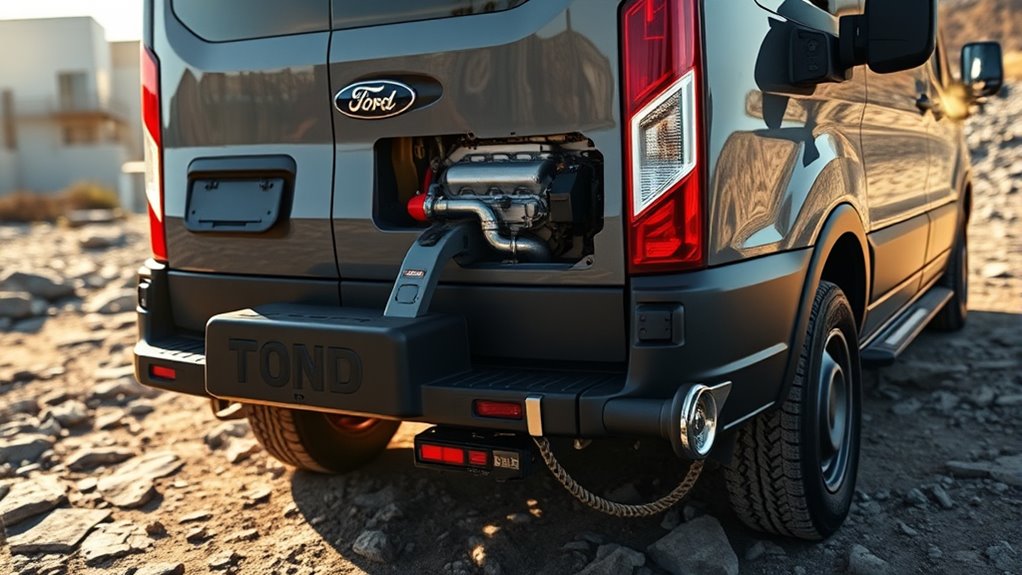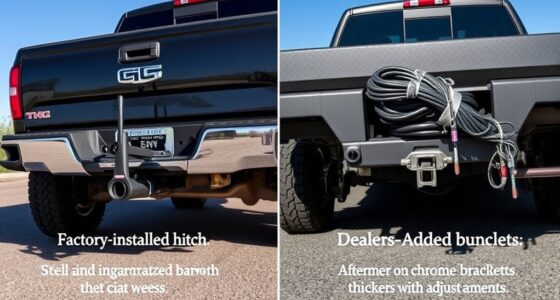Your Ford Transit’s towing capacity varies based on engine, drivetrain, and configuration. With a 3.5L EcoBoost V6 and RWD, you can tow up to around 6,900 pounds, while dual rear wheel models reach over 7,700 pounds. The PFDI V6 offers about 5,300 pounds. Drivetrain choices like AWD or RWD influence capacity further. For detailed specs tailored to your setup, continue exploring what affects towing performance and safety.
Key Takeaways
- Ford Transit towing capacities range from about 3,400 to 7,716 pounds, depending on engine, drivetrain, and configuration.
- The 3.5L EcoBoost® V6 engine with RWD can tow up to approximately 6,900 pounds.
- PFDI V6 engines typically tow around 5,300 pounds, suitable for moderate hauling needs.
- RWD models generally tow more than AWD versions, which offer better traction but slightly lower capacity.
- Vehicle configuration factors like wheelbase, roof height, and axle ratio significantly influence towing limits.
Overview of Ford Transit Towing Capabilities
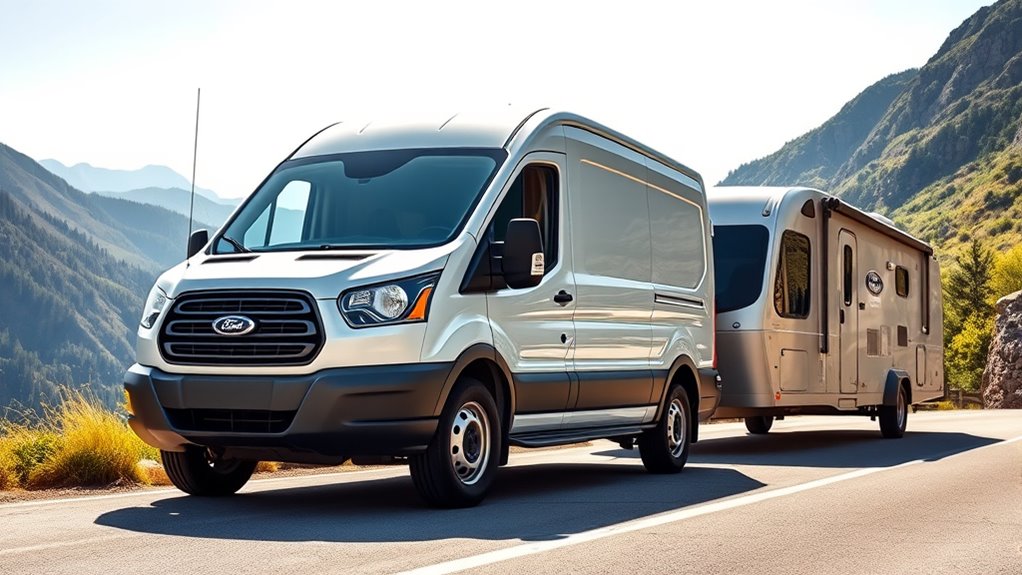
The Ford Transit offers a versatile range of towing capabilities suited for various commercial and personal needs. Depending on the model, engine, and configuration, you can tow between 3,400 and 7,500 pounds. Some versions, like the Transit 250 with a 3.5L EcoBoost® V6 and rear-wheel drive, can tow up to 6,800 pounds. The maximum towing capacity for certain models reaches 7,716 pounds when using braked trailers, especially on dual rear wheel configurations. Keep in mind, unbraked trailers are limited to around 1,650 pounds. Towing capacity varies with vehicle model and configuration, and understanding best towing practices can help maximize safety and efficiency when hauling heavy loads. Proper weight distribution and vehicle maintenance are essential for optimal towing performance. Passenger van variants generally have lower ratings than cargo models, due to differences in suspension and axles. Your towing capacity ultimately depends on specific vehicle factors, including engine choice, drivetrain, and configuration. Additionally, engine options play a significant role in determining the overall towing capacity of your Ford Transit.
Towing Capacity of the 3.5L EcoBoost® V6 Engine

The 3.5L EcoBoost V6 engine offers impressive towing capacity, with a maximum of up to 6,900 pounds when properly equipped and rear-wheel drive. Your choice of drivetrain and configuration can slightly impact this capacity, with rear-wheel drive models typically towing more than AWD versions. Understanding these variations helps you optimize your Transit’s towing performance for your specific needs. The EcoBoost engine’s high horsepower and torque output contribute significantly to its towing capabilities, making it a popular choice for those needing reliable performance. Proper system maintenance ensures the engine performs at peak efficiency and maintains its towing capacity over time. Additionally, being aware of potential vulnerabilities in engine systems can help in implementing safety measures to prevent issues.
Max Towing Limits
When equipped with the 3.5L EcoBoost® V6 engine, Ford Transit can tow impressive loads, with maximum capacities reaching up to 6,900 pounds in certain configurations. This engine delivers 310 horsepower and 400 lb-ft of torque, supporting high towing limits when paired with a rear-wheel-drive setup and the 3.73 rear axle ratio. The peak capacity is typically found in Regular Length, Low or Medium Roof models. Keep in mind, all-wheel-drive versions tend to have slightly lower towing limits. Your towing capacity also depends on the van’s payload, wheelbase, and roof height, but the EcoBoost’s performance capabilities are designed to optimize towing performance. Additionally, deals on buy options for accessories and upgrades can enhance your towing experience. For best results, understanding your vehicle’s towing capacity and adhering to safety guidelines is essential. Overall, this setup allows you to confidently tow heavy trailers and equipment, making it ideal for commercial and recreational purposes.
Drivetrain Variations
Choosing between rear-wheel drive (RWD) and all-wheel drive (AWD) options for your Ford Transit with the 3.5L EcoBoost® V6 engine can influence your towing experience. Both configurations deliver the same maximum towing capacity, but their handling differs. RWD offers a simpler mechanical layout, potentially better fuel economy, and is ideal for highway towing. AWD enhances traction and stability, especially on slippery or uneven terrain, providing better control when hauling heavy loads. This added grip can improve safety and confidence during towing, though it may add slight weight penalties. All-wheel drive systems can also be advantageous in regions with snowy or rainy weather, helping to prevent wheel spin during towing. Additionally, understanding the security of cryptocurrency investments and choosing trusted custodians are essential aspects of managing a Bitcoin IRA effectively. Regardless of drivetrain choice, the 10-speed automatic transmission ensures smooth power delivery. Your selection influences handling and safety during tow operations but doesn’t change the maximum towing capacity, allowing you to prioritize terrain, conditions, and personal preference.
Towing Performance of the 3.5L PFDI V6 Naturally Aspirated Engine

The 3.5L PFDI V6 naturally aspirated engine delivers a solid towing performance suited for moderate commercial and recreational needs. With about 275 horsepower and torque near 260 lb-ft, it handles up to 5,300 pounds of trailer weight, depending on configuration. The 10-speed automatic transmission optimizes towing efficiency. To maximize capacity, a 4.10 axle ratio is recommended. Keep in mind, payload capacity around 3,400 to 3,500 pounds influences towing limits, especially with longer wheelbases or high-roof models. Compared to the EcoBoost, which offers higher torque and towing capacity, the PFDI engine favors reliability and simpler maintenance. Proper hitch setup and weight management are essential for safe towing. Understanding load distribution can improve safety and performance when towing. Additionally, selecting appropriate engine configuration can influence overall towing capabilities. Here’s a quick comparison: Cookies ensure data is handled securely and help improve user experience on the site.
| Feature | 3.5L PFDI V6 | EcoBoost V6 | Difference |
|---|---|---|---|
| Max Towing Capacity | 5,000–5,300 lbs | 6,900 lbs | EcoBoost is higher |
| Torque | ~260 lb-ft | 400 lb-ft | EcoBoost provides more torque |
| Engine Type | Naturally aspirated | Turbocharged | Turbo vs. NA |
| Maintenance | Simpler | More complex | Longer engine life? |
| Overall Suitability | Moderate towing needs | Heavy-duty towing | EcoBoost excels for heavy loads |
Impact of Drivetrain Choices: Rear-Wheel Drive vs. All-Wheel Drive

Drivetrain choice considerably impacts towing capacity in Ford Transit models, with rear-wheel drive (RWD) configurations generally offering higher maximum limits than all-wheel drive (AWD) setups. RWD models can tow around 6,800 to 6,900 pounds with the 3.5L EcoBoost V6, making them ideal for heavy-duty tasks. In contrast, AWD versions typically have reduced capacities, often around 4,000 pounds in certain trims, due to added weight and drivetrain losses. While AWD improves traction on slippery or uneven surfaces, it introduces additional complexity and weight, which lower towing limits. RWD is better suited for flat, paved terrains and heavier towing needs, providing more stability and consistent performance. Overall, if maximum towing capacity is your priority, RWD configurations are the superior choice.
Effect of Axle Ratios on Towing Limits
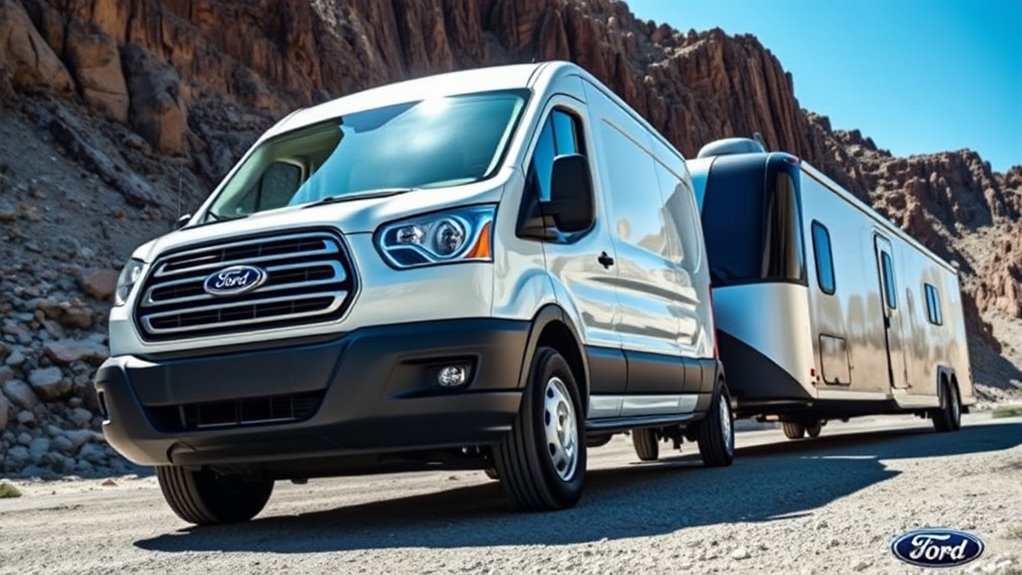
Your choice of axle ratio directly impacts your Ford Transit’s towing limits. A higher ratio, like 4.10, boosts maximum towing capacity but may reduce fuel economy. Understanding how these ratios affect performance helps you select the right setup for your towing needs. Engine performance and durability are also influenced by axle ratio choices, which can affect long-term vehicle reliability. Additionally, considering factors influencing engine longevity can ensure your vehicle maintains optimal performance over time. Proper vehicle maintenance can further enhance engine life and towing efficiency, especially when tailored to your specific towing configurations.
Axle Ratio Impact
Adjusting the axle ratio on a Ford Transit directly influences its towing limits by changing how much torque is delivered to the wheels. Higher ratios, like 3.73 or 4.10, increase torque multiplication, allowing you to tow heavier loads. For example, a 3.31 ratio might limit you to around 5,400 lbs, while a 3.73 ratio can boost capacity to approximately 6,800 lbs. The table below highlights how different ratios impact towing:
| Axle Ratio | Approximate Max Towing Capacity |
|---|---|
| 3.31 | 5,400 lbs |
| 3.73 | 6,800 lbs |
| 4.10 | 7,500 lbs |
| 3.31 w/ Towing Package | Slightly higher |
| 4.10 w/ Towing Package | Maximize capacity |
Choosing the right ratio balances towing needs with fuel economy and vehicle handling. Additionally, selecting an appropriate axle ratio can influence the overall fuel efficiency of your vehicle during towing. Understanding water parks and their features can also be helpful when planning outdoor activities on weekends or vacations. Moreover, considering the market trends in vehicle configurations can assist in making informed decisions about upgrades and modifications.
Towing Capacity Variations
Variations in Ford Transit’s towing capacity depend heavily on specific vehicle configurations beyond just axle ratios. Your vehicle’s drivetrain layout, such as rear-wheel drive or all-wheel drive, markedly influences its towing limits—rear-wheel drive models typically tow more due to efficiency. Body style also matters; cargo vans generally support higher towing weights than passenger vans with similar engines, due to differences in suspension and weight distribution. Wheelbase length affects load stability and capacity, with longer wheelbases often enabling higher towing limits. Additionally, roof height and GVWR impact the gross combination weight rating (GCWR), indirectly setting towing boundaries. Proper maintenance of tires and suspension systems is essential to ensure safe towing performance across different configurations. Proper maintenance of tires and suspension systems is essential to ensure safe towing performance across different configurations. towing capacity ratings should be properly calibrated to prevent overloading and ensure vehicle safety during towing operations. Furthermore, regulatory standards influence how towing capacities are determined and communicated to consumers, emphasizing the importance of adhering to official guidelines. Maintaining consistent vehicle maintenance and adhering to manufacturer recommendations can also help optimize towing capacity and safety.
Differences in Towing Capacity Between Cargo and Passenger Variants

The towing capacity of Ford Transit models varies considerably between cargo and passenger versions due to differences in design and specifications. Passenger variants typically have lower Gross Vehicle Weight Ratings (GVWR), limiting their payload and towing limits. Cargo models are built with higher GVWRs, allowing for heavier loads and greater towing capacity. For example, the Transit 150 passenger version caps out around 3,600 pounds payload, while the Transit 250 cargo version exceeds 4,000 pounds. Cargo models, especially the 350, feature reinforced structures and higher payload capacities, making them ideal for towing heavy loads. Conversely, passenger vans prioritize seating and comfort, which adds weight and reduces available towing limits. These differences are critical when selecting the right model for your towing needs. Higher GVWRs provide more headroom for towing heavier loads.
Towing Specifications for Different Vehicle Configurations and Sizes

Different configurations and sizes of the Ford Transit considerably influence their towing capabilities. The engine choice, drivetrain, wheelbase length, and roof height all play critical roles. For example, the 3.5L EcoBoost V6 with rear-wheel drive provides the highest towing capacity, reaching up to 6,900 pounds on Transit-150 models. In contrast, models with all-wheel drive and the standard engine typically tow around 4,000 pounds. Longer wheelbases and higher roof heights often reduce maximum trailer weight due to increased vehicle height and aerodynamics. Gear ratios also matter: a 4.10 ratio supports higher GCWRs and better towing performance than a 3.73 ratio. Overall, selecting the right configuration, drivetrain, and accessories guarantees you maximize towing capacity suited to your specific vehicle setup.
Trailer Weight Distribution and Safety Considerations

Proper trailer weight distribution is essential for safe and stable towing, so make sure most cargo is positioned near the hitch. Using the right towing equipment, like weight-distribution hitches, helps maintain balance and control. Always follow safety tips to prevent sway, uneven wear, or handling issues during your trip. Understanding trailer weight terms such as GVWR and tongue weight can help you ensure your trailer is loaded within safe limits and prevent overloading.
Proper Weight Distribution
Achieving safe and stable towing starts with understanding how to distribute weight effectively within your trailer. You should place roughly 60% of the cargo weight in the front half, near the hitch, to enhance stability. Position heavier items over the axles and toward the front to reduce sway and improve steering. Ensure weight is evenly distributed side-to-side to prevent uneven tire wear and steering issues. Properly low and heavy cargo placement lowers the center of gravity, boosting safety. Avoid placing excessive weight at the rear, which can cause sway and poor handling. Maintain the tongue weight at 10-15% of the total trailer weight to keep balance and prevent issues like jackknifing. Always verify load balance with scales or sensors to secure safe, smooth towing.
Use of Towing Equipment
Using the right towing equipment is essential for safe and effective trailer operation. You must guarantee the hitch’s maximum tongue weight rating isn’t exceeded, aiming for 10-15% of the trailer’s loaded weight to maintain stability. Be cautious with hitch-mounted accessories like cargo carriers or bike racks, as they increase tongue weight and can affect handling. Check that your hitch type and class align with your Transit’s towing limits. Always verify that your vehicle’s gross vehicle weight rating (GVWR) isn’t surpassed when loaded, including passengers and cargo. Proper towing also requires factory or dealer-installed equipment, such as upgraded axles, brake controllers, and wiring harnesses, to maximize capacity and safety. Using the correct towing gear prevents trailer sway, reduces wear, and ensures compliance with safety standards.
Safety and Stability Tips
Ensuring trailer stability while towing hinges on correct weight distribution and safety practices. You need to keep the tongue weight at 10-15% of the trailer’s total load, distribute cargo evenly, and use weight distribution hitches for heavy loads. Secure couplers, electrical connections, safety chains, and brakes before departure. Always check that your hitch and GVWR aren’t exceeded, especially with passengers and cargo onboard. Watch for trailer sway and stop to adjust loads if needed. Avoid sudden steering or speed changes to prevent destabilization. Proper setup and cautious driving are key to safety.
| Trailer Load | Proper Practice | Potential Risk |
|---|---|---|
| Excessive Tongue Weight | Use weight distribution hitches | Overloading rear suspension |
| Uneven Cargo | Distribute cargo evenly | Sway and instability |
| Loose Connections | Double-check latches and chains | Detachment or accidents |
| Heavy Cargo Inside | Calculate payload carefully | Reduced towing capacity |
| Environmental Factors | Drive cautiously on wind, slopes | Loss of control |
Practical Applications and Best Uses for Ford Transit Towing
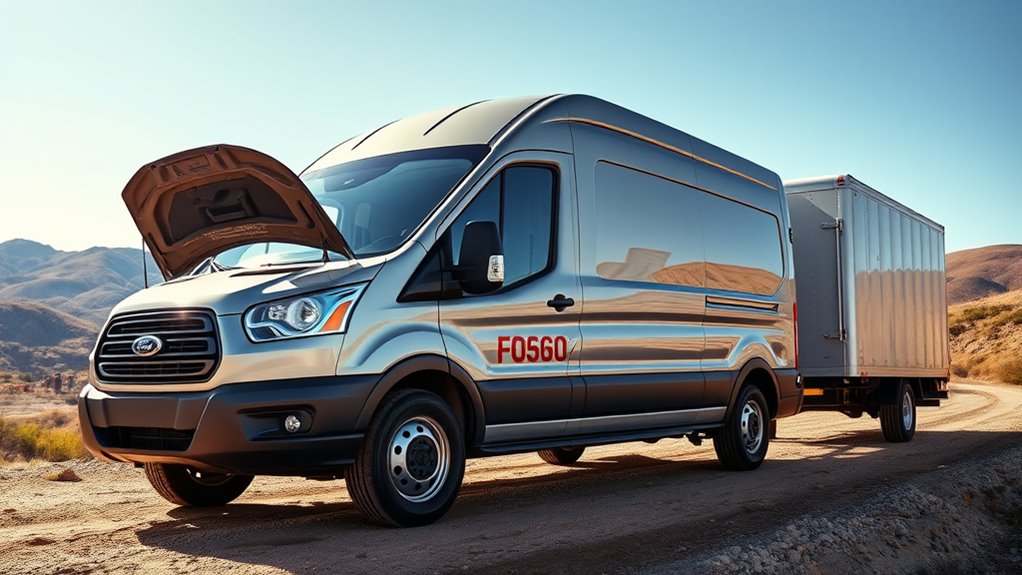
The Ford Transit’s towing capacity makes it a versatile choice for a variety of practical applications, from hauling equipment to recreational trailers. If you have a Transit 250 with a 3.5L EcoBoost V6 and rear-wheel drive, you can tow up to 6,800 lbs, perfect for travel trailers or campers. Cargo van models with higher towing capacities are ideal for hauling cargo or equipment trailers, making them suitable for trades or moving jobs. Van conversions into campers or mobile workstations can also benefit from moderate towing capabilities for smaller trailers or auxiliary gear. Keep in mind that towing heavier loads requires matching trailer weight to the vehicle’s rated capacity, especially with braked trailers. Your choice of drivetrain and vehicle configuration impacts what you can tow effectively and safely.
Recommendations for Maximizing Towing Safety and Performance

Maximizing towing safety and performance begins with proper hitch setup and load distribution. Confirm your hitch and ball size match the trailer specifications for a secure connection. Use safety pins and chains to fully secure the hitch. Distribute cargo evenly, placing heavier items near the axle to prevent sway and maintain control. Apply the 20% load reduction rule on hitch carriers to keep a safety margin. Utilize anti-rattle hitch pins to reduce movement and enhance comfort. Understanding vehicle towing limits is essential to prevent overloading and ensure safety during your trip.
Ensure proper hitch setup and load distribution for safe, smooth towing performance.
- Feel confident knowing your setup is safe and reliable
- Experience smoother, more controlled towing journeys
- Prevent accidents caused by imbalanced loads
- Enjoy peace of mind with secure trailer connections
- Maximize your Ford Transit’s towing capacity safely
Frequently Asked Questions
How Does Towing Capacity Vary With Different Ford Transit Model Years?
You’ll notice that towing capacity varies mainly by model year, with most recent models from 2018 onward maxing out around 3,500 kg (7,716 lbs). Older models, like 2009–2018, show more variation, often allowing higher loads depending on engine, configuration, and packages. Up to 2021, Ford kept capacities stable, but changes in transmission, axles, and options influenced towing limits, especially in earlier years.
Can the Ford Transit Tow Beyond Its Maximum Listed Capacity Safely?
You shouldn’t tow beyond your Ford Transit’s maximum listed capacity, as doing so increases the risk of mechanical failure and accidents. For example, exceeding the limit can cause brake failure or engine overheating. The manufacturer’s specifications are there for your safety, warranty protection, and legal compliance. Always stay within the recommended towing capacity, use proper equipment, and check your vehicle’s load to prevent dangerous situations on the road.
What Are the Impacts of Adding Aftermarket Modifications on Towing Capacity?
Adding aftermarket modifications can negatively impact your towing capacity. These changes may weaken the vehicle’s structural integrity, strain the drivetrain, and increase wear on essential components. While some upgrades like suspension enhancements can improve stability, improper or excessive modifications often reduce safe towing limits, void warranties, and risk safety. Always consult professionals and adhere to manufacturer guidelines to make sure modifications support your towing needs without compromising safety.
How Does Passenger Versus Cargo Setup Influence Towing Performance?
You’ll notice passenger setups limit your towing because extra seats and interior features add weight and reduce capacity, unlike cargo versions designed for hauling with minimal interior. While both share similar engines, cargo models often handle higher loads thanks to reinforced suspensions and better axle ratios. So, if towing heavy trailers, choose a cargo setup — it optimizes weight distribution and offers greater towing performance.
What Maintenance Considerations Are Crucial for Optimal Towing Safety?
You need to regularly check and maintain your engine oil, transmission fluid, and cooling system to guarantee your vehicle runs smoothly while towing. Inspect tires for proper pressure and wear, and keep brakes in top condition. Confirm hitch, coupler, and safety chains are secure and well-lubricated. Post-trip inspections help catch issues early. Staying on top of these maintenance tasks keeps your towing safer and prevents breakdowns or accidents.
Conclusion
Think of your Ford Transit as a skilled ship steering the open waters. By understanding its engine power, drivetrain choices, and configuration, you steer safely through towing challenges. Respect the weight limits and balance your load like a seasoned captain. With the right knowledge and care, your Transit becomes a reliable vessel, ready to carry your cargo smoothly and confidently across any journey. Master its capabilities, and you’ll always reach your destination secure and sound.
